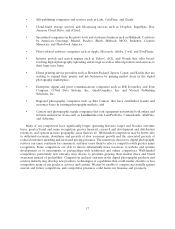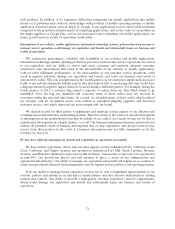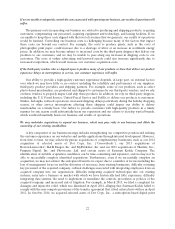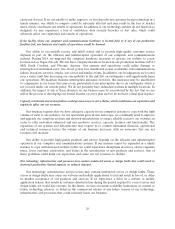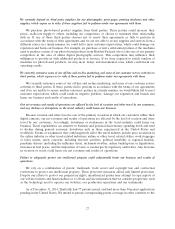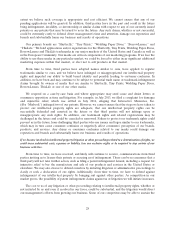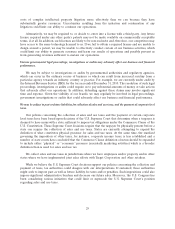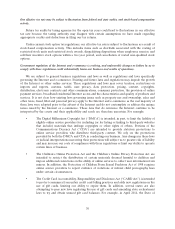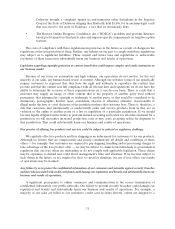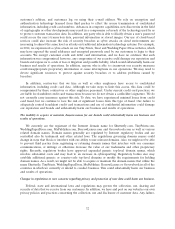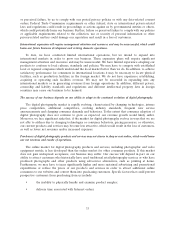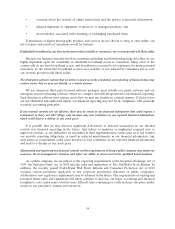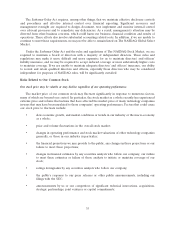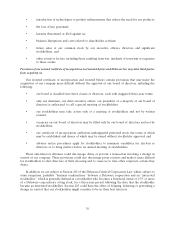Shutterfly 2014 Annual Report Download - page 28
Download and view the complete annual report
Please find page 28 of the 2014 Shutterfly annual report below. You can navigate through the pages in the report by either clicking on the pages listed below, or by using the keyword search tool below to find specific information within the annual report.We currently depend on third party suppliers for our photographic print paper, printing machines and other
supplies, which expose us to risks if these suppliers fail to perform under our agreements with them.
We purchase photo-based product supplies from third parties. These parties could increase their
prices, reallocate supply to others, including our competitors, or choose to terminate their relationship
with us. If one of these third parties chooses not to renew their agreements or fails to perform in
accordance with the terms of their agreements and we are not able to secure supplies and services from a
different source in a timely manner, we could fail to meet customer expectations, which could damage our
reputation and harm our business. For example, we purchase or rent a substantial portion of the machines
used to produce certain of our photo-based products from Hewlett-Packard, who is also one of our primary
competitors in the area of online digital photography services. This competition may influence their
willingness to provide us with additional products or services. If we were required to switch vendors of
machines for photo-based products, we may incur delays and incremental costs, which could harm our
operating results.
We currently outsource some of our off-line and on-line marketing, and some of our customer service activities to
third parties, which exposes us to risks if these parties fail to perform under our agreements with them.
We currently outsource some of our off-line and on-line marketing, and some of our customer service
activities to third parties. If these parties fail to perform in accordance with the terms of our agreements
and if we are unable to secure another outsource partner in a timely manner, we would likely fail to meet
customer expectations, which could result in negative publicity, damage our reputation and brands and
harm our business and results of operations.
Our net revenues and results of operations are affected by the level of vacation and other travel by our customers,
and any declines or disruptions in the travel industry could harm our business.
Because vacation and other travel is one of the primary occasions in which our customers utilize their
digital cameras, our net revenues and results of operations are affected by the level of vacation and other
travel by our customers. Accordingly, downturns or weaknesses in the travel industry could harm our
business. Travel expenditures are sensitive to business and personal discretionary spending levels and tend
to decline during general economic slowdowns such as those experienced in the United States and
worldwide. Events or weaknesses that could negatively affect the travel industry include price escalation in
the airline industry or other travel-related industries, airline or other travel related strikes, work stoppages
or labor unrest, safety concerns, including terrorist activities, political instability or regional hostility,
pandemic disease (including the influenza virus), inclement weather, airline bankruptcies or liquidations,
increases in fuel prices, and the imposition of taxes or surcharges by regulatory authorities. Any decrease
in vacation or travel could harm our net revenues and results of operations.
Failure to adequately protect our intellectual property could substantially harm our business and results of
operations.
We rely on a combination of patent, trademark, trade secret and copyright law and contractual
restrictions to protect our intellectual property. These protective measures afford only limited protection.
Despite our efforts to protect our proprietary rights, unauthorized parties may attempt to copy aspects of
our website features and functionalities or to obtain and use information that we consider proprietary, such
as the technology used to operate our websites, our production operations and our trademarks.
As of December 31, 2014, Shutterfly had 77 patents issued, and had more than 40 patent applications
pending in the United States. We intend to pursue corresponding patent coverage in other countries to the
27


